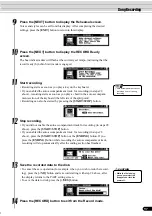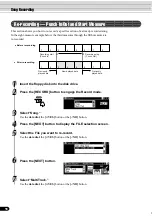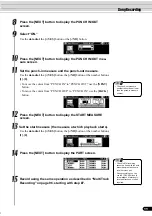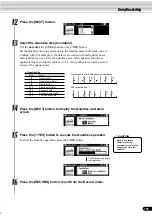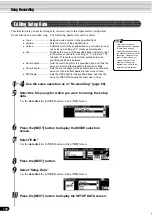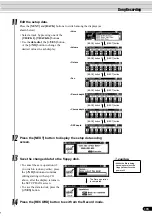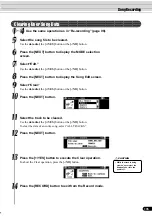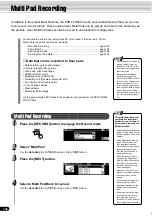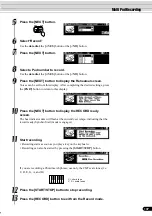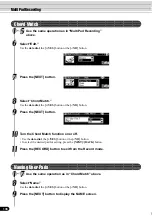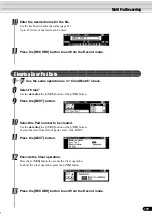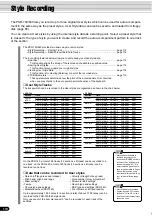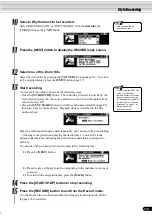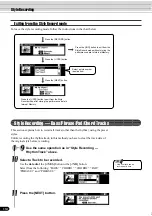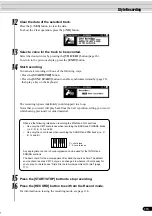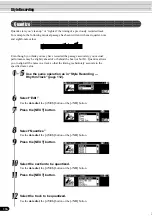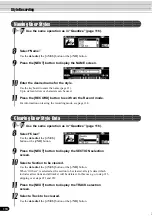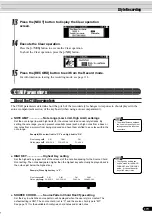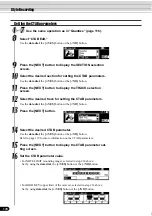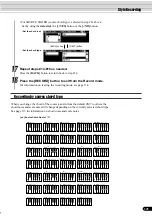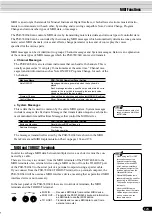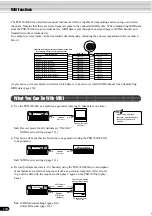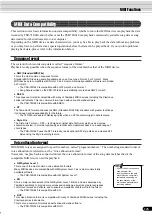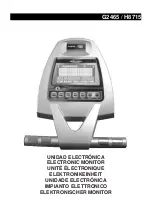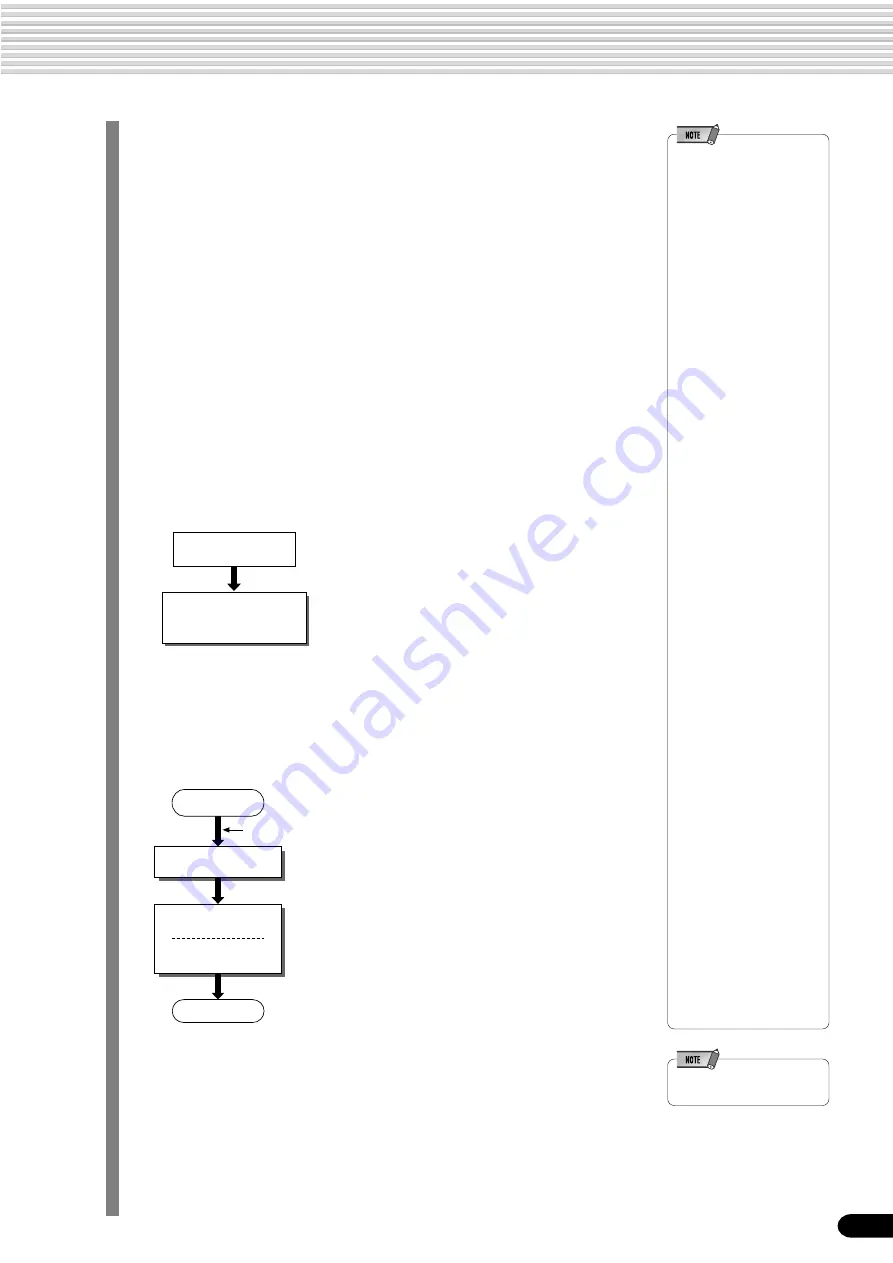
111
• “CTAB” is the abbreviation of
“Channel table”.
■
About Recording User Styles
In recording a User song, the PSR-740/640 records your keyboard performance as
MIDI data. Recording of User styles, however, is done in a different way. Here are
some of the aspects in which style recording differs from song recording:
Style Recording
Loop Recording
Auto accompaniment repeats the accompaniment patterns of several measures
in a “loop,” and style recording is also done using loops. For example, if you start
recording with a two-measure main section, the two measures are repeatedly
recorded. Notes that you record will play back from the next repetition (loop),
letting you record while hearing previously recorded material.
Overdub Recording
This method records new material to a track already containing recorded data,
without deleting the original data. In style recording, the recorded data is not
deleted, except when using functions such as Clear (page 118) and Drum
Cancel (page 113).
For example, if you start recording with a two-measure main section, the two
measures are repeated many times. Notes that you record will play back from
the next repetition, letting you overdub new material to the loop while hearing
previously recorded material.
Using Preset Styles
The following notes and
cautions are important
points for you to keep in
mind as you record your
User styles.
• Make sure to clear at least
one of the three User styles
before recording a new User
style. Recording a new User
style cannot be started when
all three User styles have
recorded data.
• Be careful to avoid the data
loss that will occur during
recording if the power is
turned off, or the AC adaptor
is unplugged from the outlet.
• Using Registration Memory
(page 62) can make your
recording sessions much
more efficient, since various
settings (such as voices,
etc.) can be recalled by a
single button press.
When the record mode is
engaged, the Registration
Memory Freeze function will
be turned on (it cannot be
turned off while the record
mode is engaged).
• Using the Metronome
function (page 134) can
make your recording
sessions much more
efficient.
• In the Record Ready mode,
you can exchange or edit the
voice data in the recorded
tracks using Mixer on page
90 or Parameter Edit on
page 91.
• If the memory becomes full
while recording, an alert
message will appear on the
display and recording will
stop.
• Since recording is done in
measure units, you should
first select a style that has
the same number of
measures as the section you
intend to record.
• If none of the preset styles is
appropriate, select one that
has the same time signature
and number of measures as
the one you want to create,
then use the Clear function
(page 118) to clear all preset
data before entering your
own.
Preset style data
Copy
Internal memory for
User style recording
As shown in the chart at left, when you select the
internal preset style that is the closest to the type
of style you wish to create, the preset style data
will be copied to a special memory location for
recording.
You create (record) your new, original style by
adding or deleting data from the memory location.
All tracks (with the exception of the rhythm track)
must be cleared before recording (page 115).
■
Style File (Auto Accompaniment) Format
The Style File Format (SFF) combines all of Yamaha’s auto accompaniment know-
how into a single unified format.
By using the User style function, you can take advantage of the power of the SFF
format and freely create your own User styles.
CTAB ......................................... page 119
The chart at the left indicates the process by
which the accompaniment is played back. (This
does not apply to the rhythm track.)
The source pattern in the chart is the original style
data. As explained on page 115, in style recording
this source pattern is recorded.
As shown in the chart at left, the actual output of
the accompaniment is determined by various
parameter settings and chord changes (playing
chords in the auto accompaniment section of the
keyboard) made to this source pattern.
CTAB is a group of parameters which determines how the pitch of the source pattern
is converted when you play chords in the auto accompaniment section of the
keyboard. The User style function gives you exceptionally detailed and comprehen-
sive control by allowing you to record the source pattern to each track and set the
CTAB parameters for each track. The PSR-740/640 lets you set the following four
CTAB parameters:
• Source Chord Root
• Source Chord Type
• Highest Key
• Note Range (Low Limit, High Limit)
For details about the CTAB parameters, see page 119.
Source pattern
(recorded data)
Note transposition
(Source Chord Root/Type)
Chord change
Accompaniment
Highest key setting
Note key settings
(Low Limit, High Limit)
109
Summary of Contents for 640
Page 1: ......

